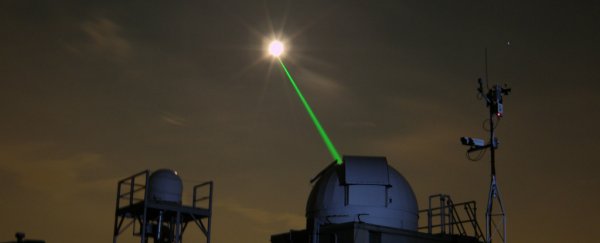We humans are pretty into the idea of finding aliens, but have we really thought through what would happen if we stumbled across extraterrestrial intelligence that didn't want to 'come in peace', and instead was hell-bent on mining our fair planet for everything it's got?
No? Well, luckily for us reckless daydreamers, astronomers have our back, and have come up with a pretty solid plan that would cloak our planet from any bad-guy aliens out there looking for us. And it relies entirely on lasers (what else?).
So how does it work? In order to find planets outside our Solar System, we watch other stars and look for signs of their light dimming periodically, which indicates that a planet is passing in front of them.
By watching how often a planet crosses its sun, and how much light it blocks, we can get a pretty good idea of how close the planet is to its star, and how big it is. And because we can't possibly examine every planet in the Universe, we use that information to work out which might be most interesting to us. So for humans, that's planets that might contain water, or could be habitable.
Assuming big-bad aliens use a similar technique to look for planets that interest them, we'd have to find a way to stop them from noticing Earth as it passes in front of the Sun if we wanted to stay off their radar - and that's where the lasers come into it.
A team from Columbia University has now proposed a system that would fire a laser at the precise moment Earth crosses in front of the Sun, so that stars lying along the same plane wouldn't even notice the light dimming.
The idea started off as an attempt to alter the signal we were broadcasting about our planet's orbit into space, but then the team realised we could actually cloak our planet entirely if we wanted.
In order to hide our existence in terms of optical wavelengths - so that no one could see us - the astronomers calculate that we'd need to blast a 30 megawatt laser for about 10 hours once a year.
That's roughly the amount of energy collected by the International Space Station's solar panels each year, as Maddie Stone reports over at Gizmodo, so it's not a totally unreasonable expenditure when you consider it could save the entire planet.
We could also scale things up and use an array of tuneable lasers that would cloak us on all wavelengths, rendering us invisible, but that would require around 250 megawatts of power.
Doing that could also make us seem more suspicious for any aliens looking closely, as there'd still be indirect traces of our planet, such as the way it affects the orbits of the rest of the planets in our Solar System. So a total cloaking system could actually make us even more interesting to extraterrestrial lifeforms.
A more efficient (and safer) plan, the researchers report, would be to only cloak the atmospheric signals associated with biological activity, such as oxygen and water vapour. That would only take up about 160 kilowatts of energy, and would make our planet look pretty uninteresting to any onlookers with questionable intentions.
"The atmospheric cloaking produces totally self consistent observations," co-author Alex Teachey told Gizmodo. "They see a planet, but they think it's a just another dead world floating out in space."
The plan's not foolproof, because we have no idea what kind of technology extraterrestrial life might have, or how they could be searching for other lifeforms in space - if they're looking for us at all. (And hopefully it goes without saying that aliens aren't necessarily going to be bad.)
But the good thing is, we already have all the technology - and energy - available to put it in place. "We could build this next week if we really wanted to," added Teachey. "It's totally feasible with current technology."
That all sounds great, but it does make you wonder… if we can cloak our planet from aliens, then what's to say they're not doing the same to us? Mind = blown.
The research has been published in the Monthly Notices of the Royal Astronomical Society.
